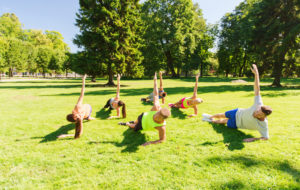While it may feel alarming to experience muscle shakes after a workout, most of the time it is completely normal. Involuntary muscle shaking is typically caused by muscle fatigue or low blood glucose.
Muscle trembles after a workout can indicate that you are just not used to the level of intensity of your previous exercise, and therefore your body is not yet able to support that level of exertion without experiencing fatigue.
The means by which your muscles move efficiently is through different motor units, a group of muscles and a motor nerve in the spine, that work together to create a smooth muscle contraction. When you work out when you are tired, malnourished, or exerting above your ability level, some of the motor units simply cease to function and lead to shaking, as explained by Dr. Loren G. Martin, professor of physiology at Oklahoma State University, as cited by LiveStrong.
This is why we tend to get the shakes in or after a barre or Pilates class. Contrary to popular belief, our muscles don’t tremble during these exercises because we haven’t used them, but because we are isolating them more than we do in other forms of exercise, and therefore they become fatigued more quickly.
Working out on an empty stomach could also be the culprit. If your body does not have enough nutrients to fuel your muscles, your level of glucose, or blood sugar, will be depleted. This condition is known as hypoglycemia, and may lead to muscle trembles.
“This is the same concept as the blood and muscle glucose availability,” explains Lauren Kanski, a NASM-certified personal trainer based out of New York, as cited by Mind Body Green. “Working out fed versus fasted can make a huge difference in glycogen depletion. With regards to muscle fatigue, some muscle fibers tire faster than others, which causes irregular contractions, or shaking.”
When muscles eventually rest, the shaking should stop.
So while the shakes may feel off-putting, they may actually be a sign of a successful workout and may indicate that we are growing stronger. Kanski notes that the idea behind strength training is to damage our tissue so that the body can regenerate new, stronger, and more durable tissue. That is the reason our bodies become sore.
If you wish to stop muscle trembling, the easiest way would be to lower the intensity of your workout until you are able to strengthen your muscles to a higher level. Another option would be to consider lowering the number of reps you perform per set, or increasing the length of time between your sets.
Eating a nutritious meal at least an hour before your workout can also help prevent muscle shaking. In particular, snacks high in carbohydrates or natural sugars, such as peanut butter or a glass of orange juice, can ease muscle shaking from hypoglycemia.
Other factors that may contribute to shaking after exercise include consuming excessive amounts of alcohol, alcohol withdrawal, caffeine intake, or other medications. Individuals experiencing stress and anxiety may also see it manifested in their body through trembles. In rare cases, a medical disorder that affects the nerves, such as multiple sclerosis or Parkinson’s disease, can be behind muscle trembles.




